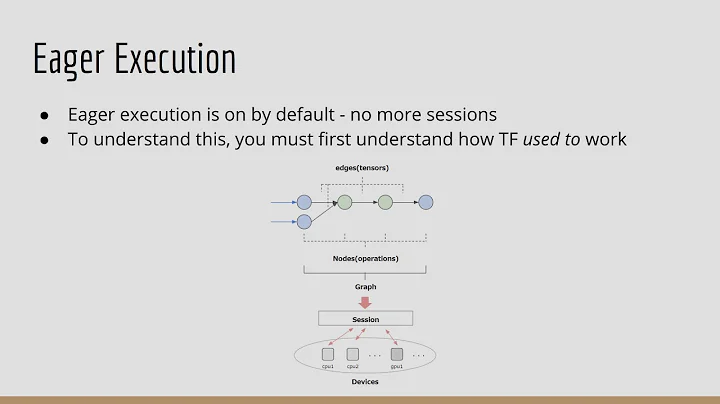Inputs to eager execution function cannot be Keras symbolic tensors
Solution 1
One alternative solution is to pass weights as additional output features rather than input features.
This keeps the model completely free of anything weights related, and the weights appear only in the loss function and the .fit() call:
import numpy as np
import tensorflow as tf
from tensorflow.keras import layers, losses, models
data_x = 2 * np.ones((7, 11, 15, 3), dtype=float)
data_y = 5 * np.ones((7, 9, 13, 5), dtype=float)
x = layers.Input(data_x.shape[1:])
y = layers.Conv2D(5, kernel_size=3)(x)
model = models.Model(inputs=x, outputs=y)
def loss(y_true, y_pred):
(y_true, w) = tf.split(y_true, num_or_size_splits=[-1, 1], axis=-1)
loss = tf.squeeze(w, axis=-1) * losses.mse(y_true, y_pred)
tf.print(tf.math.reduce_mean(y_true), "== 5")
tf.print(tf.math.reduce_mean(w), "== 3")
return loss
model.compile(loss=loss)
data_w = 3 * np.ones((7, 9, 13, 1), dtype=float)
data_yw = np.concatenate((data_y, data_w), axis=-1)
model.fit(data_x, data_yw)
One drawback still is that you need to manipulate (potentially) large arrays when merging y and w in numpy.stack(), so anymore more TensorFlow-like will be appreciated.
Solution 2
Another way:
from tensorflow.keras import layers, models, losses
import numpy as np
def loss_fcn(y_true, y_pred, w):
loss = w * losses.mse(y_true, y_pred)
return loss
data_x = np.random.rand(5, 4, 1)
data_w = np.random.rand(5, 4)
data_y = np.random.rand(5, 4, 1)
x = layers.Input([4, 1])
y_true = layers.Input([4, 1])
w = layers.Input([4])
y = layers.Activation('tanh')(x)
model = models.Model(inputs=[x, y_true, w], outputs=y)
model.add_loss(loss_fcn(y, y_true, w))
model.compile()
model.fit((data_x, data_y, data_w))
I think this is the most elegant solution.
Solution 3
Your code works just fine with latest tensorflow (2.3) if you replace your fit row with
model.fit((data_x, data_y, data_w))
So:
import numpy as np
import tensorflow as tf
from tensorflow.keras import layers, losses, models
# HERE
def loss_fcn(y_true, y_pred):
w = y_pred[:, :, -1] # HERE
y_pred = y_pred[:, :, :-1] # HERE
loss = w * losses.mse(y_true, y_pred)
return loss
data_x = np.random.rand(5, 4, 1)
data_w = np.random.rand(5, 4, 1) # HERE
data_y = np.random.rand(5, 4, 1)
x = layers.Input([4, 1])
w = layers.Input([4, 1]) # HERE
y = layers.Activation('tanh')(x)
output = layers.Concatenate()([y, w]) # HERE
model = models.Model(inputs=[x, w], outputs=output) # HERE
loss = loss_fcn # HERE
model.compile(loss=loss)
model.fit((data_x, data_y, data_w))
print('Done.')
Further, I found tf.reduce_mean, K.mean, tf.square, tf.exp etc. implemented in a loss funtion cause the same error.
Related videos on Youtube
bers
Updated on June 04, 2022Comments
-
bers almost 2 years
I am trying to implement sample- and pixel-dependent dependent loss weighting in
tf.Keras(TensorFlow 2.0.0rc0) for a 3-D U-Net with sparse annotation data (Cicek 2016, arxiv:1606.06650).This is my code:
import numpy as np import tensorflow as tf from tensorflow.keras import layers, losses, models # disabling eager execution makes this example work: # tf.python.framework_ops.disable_eager_execution() def get_loss_fcn(w): def loss_fcn(y_true, y_pred): loss = w * losses.mse(y_true, y_pred) return loss return loss_fcn data_x = np.random.rand(5, 4, 1) data_w = np.random.rand(5, 4) data_y = np.random.rand(5, 4, 1) x = layers.Input([4, 1]) w = layers.Input([4]) y = layers.Activation('tanh')(x) model = models.Model(inputs=[x, w], outputs=y) loss = get_loss_fcn(model.input[1]) # using another loss makes it work, too: # loss = 'mse' model.compile(loss=loss) model.fit((data_x, data_w), data_y) print('Done.')This runs fine when disabling eager execution, but one of the points of TensorFlow 2 is to have eager execution by default. What stands between me and that goal is the custom loss function, as you can see (using
'mse'as a loss removes that error, too):File "MWE.py", line 30, in <module> model.fit((data_x, data_w), data_y) [...] tensorflow.python.eager.core._SymbolicException: Inputs to eager execution function cannot be Keras symbolic tensors, but found [<tf.Tensor 'input_2:0' shape=(None, 4) dtype=float32>]What can I do to make this kind of structure work with eager execution?
One idea that I had was to concatenate
wto the outputyand separatey_predinto the originaly_predandwin the loss function, but this is a hack I'd like to avoid. It works, though, with changes marked by# HERE:import numpy as np import tensorflow as tf from tensorflow.keras import layers, losses, models # HERE def loss_fcn(y_true, y_pred): w = y_pred[:, :, -1] # HERE y_pred = y_pred[:, :, :-1] # HERE loss = w * losses.mse(y_true, y_pred) return loss data_x = np.random.rand(5, 4, 1) data_w = np.random.rand(5, 4, 1) # HERE data_y = np.random.rand(5, 4, 1) x = layers.Input([4, 1]) w = layers.Input([4, 1]) # HERE y = layers.Activation('tanh')(x) output = layers.Concatenate()([y, w]) # HERE model = models.Model(inputs=[x, w], outputs=output) # HERE loss = loss_fcn # HERE model.compile(loss=loss) model.fit((data_x, data_w), data_y) print('Done.')Any other ideas?
-
 vgoklani over 4 yearsHave you tried training directly without using .fit() like this example: tensorflow.org/beta/guide/keras/…
vgoklani over 4 yearsHave you tried training directly without using .fit() like this example: tensorflow.org/beta/guide/keras/… -
bers over 4 years@vgoklani no, not yet. Thanks for the hint!
-
Luke over 4 yearsProblem with that is that you lose a lot of the convenience of keras (i.e. callbacks).
-
bers over 4 yearsCould you please explain why this works? I have an idea, but I am not sure I understand the concept behind it. Are you suggesting that
y_truewas the tensor that my MWE had a problem with, and notw? Because I don't see any change inw. -
feature_engineer over 4 years@bers I think the problem was with your function returning an inner function using the symbolic tensor. using a function which returns a symbolic tensor, instead of a function works, since that returned symbolic tensor is lazily evaluated.
-
 Stefan Falk almost 4 years@feature_engineer This makes sense but if I do this i am getting
Stefan Falk almost 4 years@feature_engineer This makes sense but if I do this i am gettingValueError: No gradients provided for any variable: [...]- any idea why this might happen?














